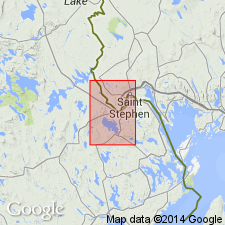
- Usage in publication:
-
- Pocomoonshine Lake Formation
- Modifications:
-
- First used
- Dominant lithology:
-
- Slate
- Siltstone
- Pelite
- AAPG geologic province:
-
- New England province
Summary:
Pocomoonshine Lake Formation is here [informally] named and assigned to the base of the newly named [informal] Wapsaconhagan Brook Group. Unit was previously mapped in the study area as the lowest informal member of the Cookson Formation (Ludman, 1985), which is here stratigraphically restricted in ME. Dark gray to gray-black, strongly cleaved, carbonaceous slates with abundant pyrite compose most of the formation. Intercalated with the pelites are thin beds of buff-weathering siltstone or very fine grained sandstone. Based on the exposed outcrop widths and the interpreted structural history, a minimum thickness is estimated at 200 m. Unit gradationally, or in some places, abruptly, underlies Kendall Mountain Formation (new [informal] name) and overlies undifferentiated sedimentary rocks. Probably correlates with Navy Island Formation of the St. John Group of southeastern New Brunswick and Penobscot Formation to the southwest. Cambrian age assignment is based on stratigraphic position below the Early Ordovician Cookson. [Pocomoonshine Lake is also naming feature for Pocamoonshine Gabbro-diorite of Larrabee, 1964.]
Source: GNU records (USGS DDS-6; Reston GNULEX).
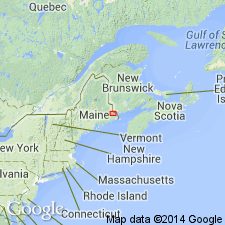
- Usage in publication:
-
- Pocomoonshine Lake Formation
- Modifications:
-
- Named
- Dominant lithology:
-
- Slate
- Siltstone
- Sandstone
- AAPG geologic province:
-
- New England province
Summary:
Pocomoonshine Lake Formation is here formally named as the lowermost subdivision of the Cookson Group (rank raised) in southeastern ME. Unit consists of dark gray to black, slightly to highly carbonaceous slate thinly interbedded with lesser amounts of siltstone and fine-grained sandstone. Slates are strongly cleaved and contain abundant primary and secondary pyrite. The formation is in tectonic contact on the west with the Flume Ridge and Digdeguash Formations of the Fredericton Trough and therefore the base of the formation has not been observed. What lies beneath is unknown. Gradationally underlies the Kendall Mountain Formation (new name). Minimum thickness is 150 m. Age is inferred to be Late Cambrian based on stratigraphic position below the youngest Cookson unit, the Early Ordovician Calais Formation (new name). [Oral commun. with Ludman, 5/89, confirms that unit was informally named in a 1986 open-file report.]
Source: GNU records (USGS DDS-6; Reston GNULEX).
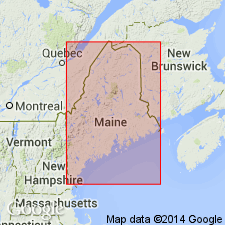
- Usage in publication:
-
- Pocomoonshine Lake Formation
- Modifications:
-
- Age modified
- AAPG geologic province:
-
- New England province
Summary:
Stratigraphic order of the formations within the Cookson Group is here revised based on new fossil evidence. Ascending, these units are Calais, Woodland, Pocomoonshine Lake, and Kendall Mountain Formations. The Digdeguash, previously considered Silurian, is here included in the Cookson as an equivalent of the Woodland and Pocomoonshine Lake Formations. Kendall Mountain, once thought to be Cambrian and placed near the base of the Cookson, contains Caradocian graptolites and is now considered youngest preserved part of the Group. Calais Formation, at the base of the Cookson, has been dated as Arenigian (Tremadocian). Woodland, once inferred to be Late Cambrian, now believed to be Ordovician based on its conformable contact with the overlying Kendall Mountain. Pocomoonshine Lake is the only unit within the Cookson that does not extend into CAN. Its recognized stratigraphic position conformably below the Kendall Mountain has not changed, though its inferred age is now Ordovician. Interfingers upper part of Woodland Formation; correlates upper part of Digdeguash Formation. Cookson then ranges from Early to Middle [Late] Ordovician.
Source: GNU records (USGS DDS-6; Reston GNULEX).
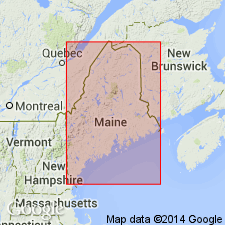
- Usage in publication:
-
- Pocomoonshine Lake Formation
- Modifications:
-
- Revised
- Age modified
- AAPG geologic province:
-
- New England province
Summary:
Author disagrees, in part, with revisions of Cookson proposed by Fyffe and Riva (1990). Though he agrees that fossil evidence requires inversion of the stratigraphic sequence, he states that the Pocomoonshine Lake and Digdeguash formations are more likely a part of the Fredericton belt rather than of the St. Croix terrane and therefore are not part of the Cookson Group. Interpretation is based on lithologic and structural evidence. As here revised the Late Cambrian(?) to Middle Ordovician Cookson comprises (ascending) Calais, Woodland, and Kendall Mountain Formations. Cookson Group tectonically underlies (ascending) Pocomoonshine Lake, Digdeguash, and Flume Ridge Formations. Pocomoonshine Lake Formation is here assigned a Late Ordovician and Silurian age.
Source: GNU records (USGS DDS-6; Reston GNULEX).
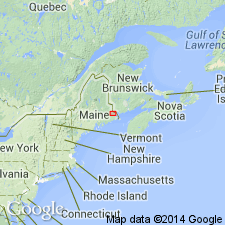
- Usage in publication:
-
- Pocomoonshine Lake Formation
- Modifications:
-
- Age modified
- AAPG geologic province:
-
- New England province
Summary:
Pocomoonshine Gabbro-Diorite intrudes the Pocomoonshine Lake, Digdeguash, and Flume Ridge Formations in the Fredericton belt and cuts the Kendall Mountain and Woodland Formations of the Cookson Group in the St. Croix belt. The pluton was emplaced during two separate episodes during the Silurian Period. 40Ar/39Ar hornblende ages form the northern mafic portion indicate crystallization at 422.7+/-3.0 Ma. Muscovite plateau age of 414.2+/-3.2 Ma is minimum age for central and southern dioritic portions of the pluton. Therefore, deposition of the Pocomoonshine Lake, Digdeguash, and Flume Ridge Formations is constrained to Late Caradocian (early Late Ordovician) through Early Silurian. The Cookson Group is interpreted as Late Cambrian(?) through Late Ordovician. According to authors, a major episode of folding and regional metamorphism must have taken place during the Silurian. Melding of the Fredericton, St. Croix, and Coastal Volcanic belts into a single block must have occurred by the Silurian. Accretion of this composite block to ancestral North America, then, was probably responsible for the Acadian Orogeny in northern New England.
Source: GNU records (USGS DDS-6; Reston GNULEX).
For more information, please contact Nancy Stamm, Geologic Names Committee Secretary.
Asterisk (*) indicates published by U.S. Geological Survey authors.
"No current usage" (†) implies that a name has been abandoned or has fallen into disuse. Former usage and, if known, replacement name given in parentheses ( ).
Slash (/) indicates name conflicts with nomenclatural guidelines (CSN, 1933; ACSN, 1961, 1970; NACSN, 1983, 2005, 2021). May be explained within brackets ([ ]).

